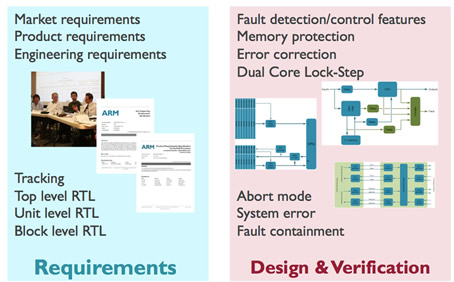Especially for organizations in Silicon Valley and elsewhere that are just entering the automotive marketplace, implementing strict requirements management and complying with standards such as ISO 26262 are new ventures. Whereas industries such as consumer electronics are more forgiving to companies that bypass certain functional safety requirements in the name of shipping product more quickly and at lower costs, the automotive sector is based on comparatively interminable development cycles, and for good reason – the functional safety of automotive systems is a matter of life and death every time a car starts.
Unfortunately, while the ISO 26262 standard and other automotive engineering guidelines offer a handbook for developing functionally safe components and systems, they are not altogether straightforward, nor are they actually required by any governing body. The reason these standards are full of intricate nuances is largely thanks to increasing complexity in the multi-tiered automotive supply chain.
In contrast with the siloed, geographically integrated automotive ecosystems of the past, today’s automotive supply chains have seen a munging of roles as players enter the market and new capabilities emerge such as ADAS and autonomous drive, connected car/eMobility, and the software-defined car. Mobileye, for instance, produces both vision SoCs and full vision systems, which are historically roles filled by Tier 1 and Tier 2/3 suppliers. The rabbit hole gets even deeper, as semiconductor IP providers also now provide building blocks that aid in the creation of specialized chips.
Still, the value of ISO 26262 certification by organizations like TÜV SÜD is apparent. For both automakers and their suppliers, getting this stamp of approval from an independent third-party engineering evaluation agency not only validates the quality of software and hardware components integrated into the system stack, it also helps protect automotive electronics vendors against malpractice or negligence in the event of injury or death caused by supposed electronic system failure.
The final responsibility for certification lies with the auto manufacturer, who is tasked with compiling documentation and other engineering evidence into a package for certifying bodies. However, without a clearly defined procedure as to what or how automotive systems and development processes are certified, suppliers are often subjected to not only rigorously managing both product and functional safety requirements, but providing these artifacts to multiple clients, often in different ways, as well.
...
Continue reading at Embedded Computing Design
2018-08-04
 Requirements.com
All about Requirements
2019-03-24
SuperUser Account
Managing functional safety in complex automotive supply chains
Requirements.com
All about Requirements
2019-03-24
SuperUser Account
Managing functional safety in complex automotive supply chains
